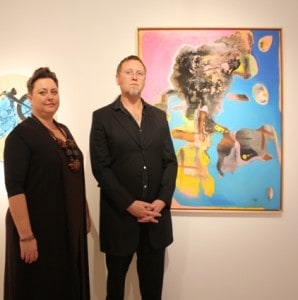
Suzette Major and Anthony Chiappin, pictured with the graphic design lecturer’s painting at the Hastings City Art Gallery.
When does graphic design become art, and if there is a distinction, who gets to draw the line? Why should it matter and to whom?
EIT graphic design lecturer Anthony Chiappin’s entry in this year’s Creative Hawke’s Bay Invitational triggers such questions around the professional practice of art. The multidisciplinary work, a painting on canvas, challenges simplistic notions about rigid classifications for creative endeavours.
Anthony painted Episode 7 The Likely Demeanour of a Suburban Nightmare in 2009 as part of an ongoing series. Various materials such as enamel and road marking spray have been applied to the canvas, creating a multi-layered, mixed media effect that some viewers might be tempted to categorise as graphic design.
But as Anthony points out, because he’s a graphic designer doesn’t mean he can’t be an artist. In fact, he says, he is “a very hard core” painter and sculptor.
“All creative art requires problem-solving skills. It’s about ideas, concepts and how to represent them in a visually graphic manner. At EIT, we encourage our students to develop these transferable skills so they can apply them to whatever field of artistic endeavour they happen to be working in. “
Anthony practises what he preaches. After graduating with a Master of Visual Arts from Monash University in Melbourne, this Australian of Italian descent moved into the advertising industry as a creative director.
Later, he launched into an academic career, spending 10 years at the Australian Academy of Design lecturing students enrolled in the affiliate of Charles Sturt University’s Bachelor of Design Arts (Graphic Design) programme.
Moving to Hawke’s Bay in 2009 to take up his position at EIT, he says his lectures are a mix of design and visual arts – an educational approach that squares with that of EIT’s new Head of School, Arts and Design, Dr Suzette Major.
In fact, says Suzette, the similarities and relationships that the Invitational’s exhibiting artists see between disciplines is very much what EIT’s Bachelor of Visual Arts and Design is about.
“Anthony’s work embodies what we now stress to students here. Many New Zealand arts schools put firm lines around areas of creative endeavour, with their students majoring, for example, in areas such as sculpture, painting and graphic design.
“We feel the best thing we can do for our students is to encourage and support them to venture into grey territory; to not view life as a world with black and white boundaries. Artists and designers have a lifetime to specialise – they don’t need to do it in their degrees.
“Rather than focusing on learning specialist techniques, it’s important that they open their minds, try things out, be playful and take risks with their art.”
Anthony says the approach taken by some art schools in encouraging students into specialist areas runs counter to what’s happening in the industry.
“I was hired by an advertising agency as an art director although I wasn’t trained for that. They had faith in my ability to raise questions about the way things could be done.”
Suzette agrees. “We teach creativity at EIT, and our graduates should be the most employable on the planet. We want to change mindsets about what we do. The school is undergoing tremendous change and we want to challenge misconceptions, to have people let go and embrace the change.”
The significant role EIT plays in nurturing creative talent is very evident at the Invitational, which continues at the Hastings City Art Gallery until June 26. Now in its fifth year, the prestigious exhibition showcases art that is representative of the region’s best. Seven of the current exhibitors are EIT staff, nine have taught at the School of Arts and Design and 14 are former students.

